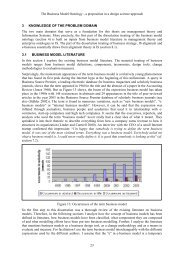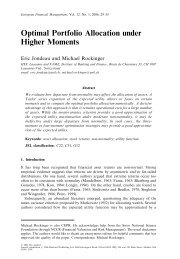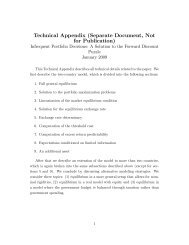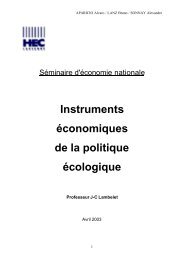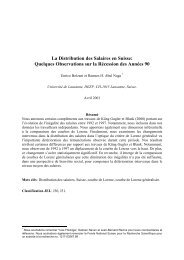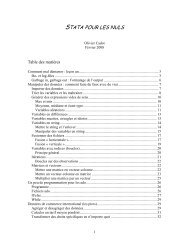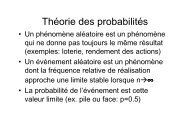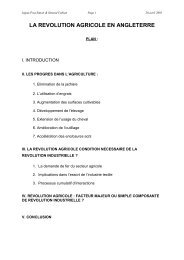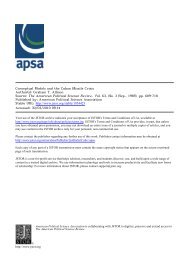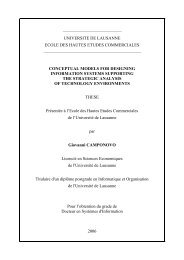Do consumer s tastes differ final 1.7. - HEC
Do consumer s tastes differ final 1.7. - HEC
Do consumer s tastes differ final 1.7. - HEC
Create successful ePaper yourself
Turn your PDF publications into a flip-book with our unique Google optimized e-Paper software.
D O C ONSUMER’ S T ASTES D IFFER?<br />
2. Common Demand Model<br />
The common demand model provides an informal analysis of the extent to which the estimates of the<br />
individual country model <strong>differ</strong> across countries and will provide some preliminary evidence regarding<br />
the similarity – or lack thereof – of <strong>consumer</strong>s.<br />
As the weighted mean of the income coefficients and of the income flexibility 6 are not too <strong>differ</strong>ent<br />
from their unweighted counterparts of model 1, it can be suspected that weights do not seem to play<br />
a vital role.<br />
A plotting of income coefficients and their weighted means and of income flexibility and its weighted<br />
means give a clear result: among the 165 points in the 11 plots, all except 8 lie within the twostandard<br />
error bands constructed using the root-mean-square- error (95% lie within the bands). This<br />
finding points in the direction of similarity of <strong>consumer</strong>s in the countries, as measured by the<br />
coefficients i β and φ .<br />
3. Formally Pooled Demand System<br />
The third model directly includes the hypothesis of similar <strong>tastes</strong> as it specifies that the coefficients of<br />
the demand equations, the demand parameters, are the same in all countries. The data is being<br />
pooled to estimate a common system for all 15 countries, i.e.<br />
commodities and c = 1,...,15 countries.<br />
c<br />
β i = i β<br />
c<br />
φ<br />
=<br />
φ<br />
, with i = 1,...10<br />
c<br />
α<br />
As the constant terms i take account of non-economic factors, they have a <strong>differ</strong>ent status and<br />
therefore Selvanathan allowed them to vary across countries. The error terms are assumed to be<br />
normally distributed with zero means and independent over time and countries.<br />
In other models, a comparison of data from individual countries was rather difficult, as it was<br />
expressed in national currencies, being converted to a common currency, using prevailing exchange<br />
rates or purchasing power parities. Selvanathan expresses prices, quantities and incomes in logarithmic<br />
change-form. The changes are unit-free and therefore can be pooled internationally.<br />
When running a likelihood ratio test, here testing the similarity of the individual-country estimates<br />
(model 1) and their standard errors with this unrestricted model, the test confirms the similarity of the<br />
pooled estimates and the weighted means.<br />
The finding that ninety-five percent of the individual-country estimates lie within the two-standarderror<br />
bands and that the pooled estimates are very close to the weighted means, implies that the<br />
pooled estimates are not too <strong>differ</strong>ent from those of the individual country model. Since additionally<br />
the estimates from model 2 and 3 are not significantly <strong>differ</strong>ent from one another, Selvanathan<br />
concentrates on model 3.<br />
A too high value for ✪² is obtained on the basis of the likelihood test, making it impossible to accept<br />
the pooled model. This is a puzzling result, but Selvanathan suspects that the asymptotic test is not<br />
performing satisfactorily, as it has also been found to be the case for homogeneity and symmetry<br />
testing. As the author uses the hypothesis of preference independence, where goods do not interact<br />
in the <strong>consumer</strong>’s utility function, the utility function is additive. In contrast to previous tests,<br />
Selvanathan’s is distribution-free and does not rely on asymptotic theory. Therefore, the pooled model<br />
does not need to be rejected due to the results of the likelihood ratio test.<br />
4. Theil’s Cross-Country Demand System<br />
The fourth model that Selvanathan uses to clarify <strong>consumer</strong> behaviour, is a model used by Theil (1987)<br />
where countries play the role of time periods, so that now the unit of observation is countries,<br />
whereas before it was years. Another major <strong>differ</strong>ence is that in his 30-country sample, only 9 of the<br />
15 OECD countries included above are used.<br />
When comparing this model’s estimates with the ones of the pooled model (3), hardly any similarities<br />
are found. Nevertheless, one needs to be aware that the models are not strictly comparable, as on the<br />
one hand, model 3 has constant terms, which allow for trend-like changes in <strong>tastes</strong> etc. and Theil’s<br />
6 income flexibility = reciprocal of the income elasticity of the marginal utility of income<br />
B EKE T INNEBERG 6<br />
19 MARCH 2003




